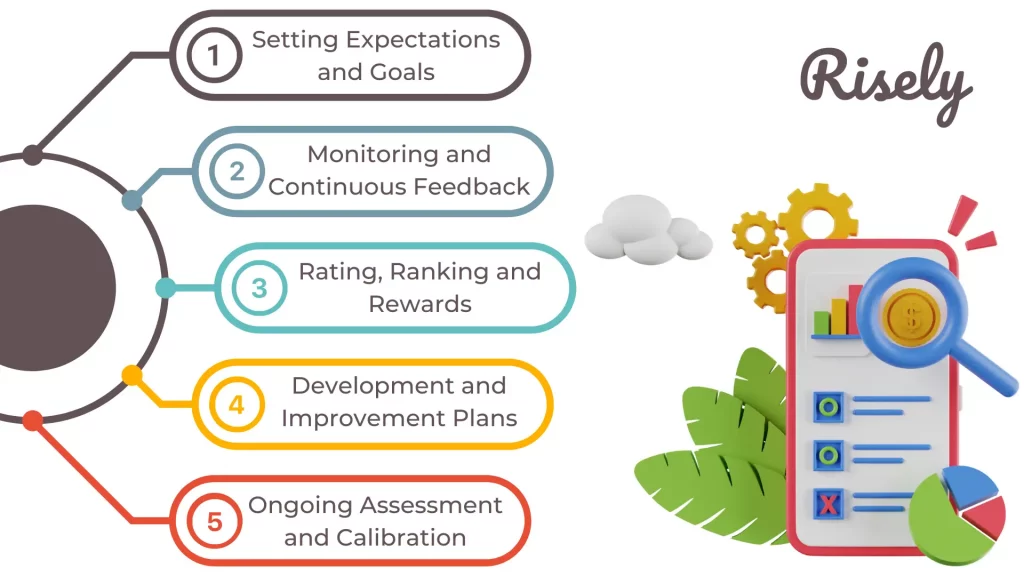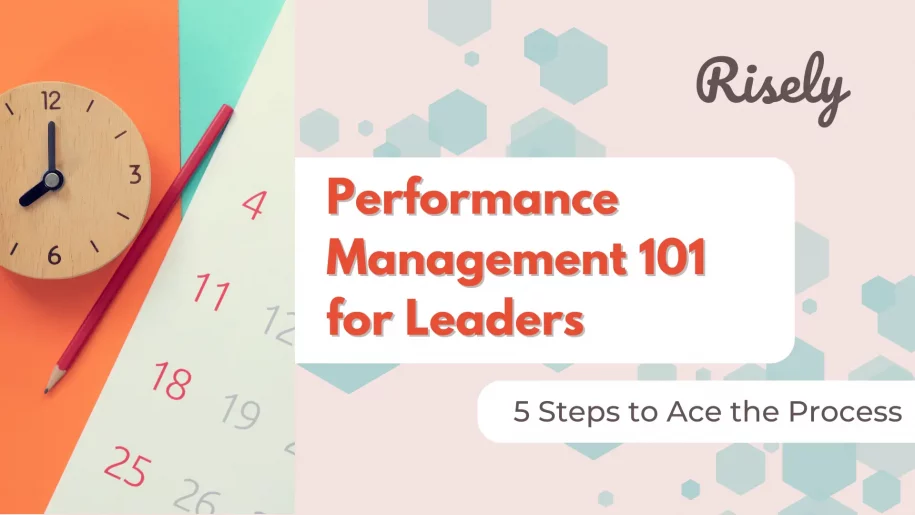Performance Management 101 for Leaders: 5 Steps to Ace the Process
As a leader, you know your team’s performance is the key to achieving your business goals. But how can you ensure everyone on your team performs at their best? The answer lies in effective performance management. Performance management is a process of setting expectations, monitoring progress, providing feedback, and rewarding employees for their achievements. This blog will cover the basics of performance management, including its benefits, frameworks, and key skills required for effective implementation. We will also provide five steps to ace the performance management process and examples of successful practices leading organizations use. Additionally, we’ll discuss building a culture of continuous feedback and improvement and drive employee engagement through performance management. Finally, we’ll touch upon common mistakes to avoid and challenges to overcome when implementing successful performance management in your organization.- Performance Management 101 for Leaders: 5 Steps to Ace the Process
- What is Performance Management?
- Benefits of Performance Management for Leaders
- What is the Performance Management Process?
- Best Practices for Performance Management
- Conducting Performance Management Training for Managers
- How to Build a Culture of Continuous Feedback and Improvement?
- How to Drive Employee Engagement through Performance Management?
- Essential Skills Required for Effective Performance Management
- Examples of Successful Performance Management Practices Used by Leading Organizations
- Common Mistakes to Avoid in Performance Management
- Challenges in Implementing Successful Performance Management
- How to Measure the Success of Performance Management Efforts?
- Wrapping up
- Other Related Blogs
What is Performance Management?
Performance management is a strategic process that aims to improve employee performance and align it with organizational goals. It involves setting clear expectations, providing ongoing feedback and coaching, assessing performance, and recognizing achievements. This process ensures that employees are working towards the organization’s objectives.Benefits of Performance Management for Leaders
Performance management offers several benefits for leaders. Leveraging the right technology and HR resources, leaders can implement it as a continuous process, leading to improved workflow and better decision-making and an overall impact creating positive outcomes such as –- It improves employee engagement and productivity by ensuring stakeholders interact often and realign their priorities if they lose focus.
- Addresses performance gaps effectively by keeping continuous checks.
- Enhances team communication and collaboration, fostering a positive organizational culture.
- Supports talent development and succession planning, ensuring a skilled workforce.
- Drives business results and aligns employees’ goals with organizational goals.
- Implementation as a continuous process leads to improved workflow and decision-making.
What is the Performance Management Process?
Step 1 – Setting Expectations and Goals
Leaders play a crucial role in performance management by establishing clear expectations and goals aligned with organizational objectives. Goal-setting should follow the SMART approach, ensuring that goals are specific, measurable, attainable, relevant, and time-bound. Involving employees in the goal-setting process increases their ownership and motivation. Effective communication of expectations and goals ensures clarity and understanding among team members. Regularly reviewing and updating plans keeps them relevant and meaningful as the workforce and strategic objectives of the organization evolve.Step 2 – Continuous Monitoring and Feedback
Leaders must provide ongoing feedback to their workforce to address performance issues and reinforce good performance. Regular check-ins and one-on-one meetings with team members facilitate open communication and promote transparency. Leaders can effectively track progress and evaluate performance by using key performance indicators (KPIs). Encouraging self-reflection and self-assessment empowers employees in their development. Leveraging the right technology allows for real-time feedback and performance tracking, making continuous monitoring and feedback a crucial aspect of performance management.Step 3 – Development and Improvement Plans
Leaders should identify professional development opportunities to support employee growth and address performance gaps. Creating individual development plans that focus on enhancing skills and competencies is important. Offering training programs, workshops, and mentoring/coaching sessions can significantly contribute to employee development. Providing constructive feedback is essential in guiding employees’ improvement efforts. Organizations should strive to foster a culture of continuous learning and development to support their workforce. By incorporating these strategies into performance management, leaders can help team members achieve their goals and drive overall organizational success.Step 4 – Rating, Ranking and Rewards
Evaluate employee performance objectively by utilizing established criteria. Differentiate performance levels with the use of rating scales or ranking systems. Motivate and retain talent by recognizing and rewarding high performers. Consider both financial and non-financial rewards and recognition to foster employee motivation. Ensure fairness and transparency in the performance evaluation process. By incorporating these strategies into the performance management process, leaders can effectively assess and reward their workforce, aligning individual goals with the organization’s strategic objectives. Utilizing the right technology, such as HR technology, can streamline the workflow and facilitate the continuous training and development process.Step 5 – Ongoing Assessment and Calibration
Continuously assess performance throughout the performance management cycle, regularly calibrating performance ratings for fairness. Incorporate feedback from multiple perspectives, including peers and subordinates. Make data-driven decisions based on evidence and performance metrics, adapting goals and development plans as needed. By utilizing the right technology, HR can streamline the ongoing assessment and calibration process, ensuring consistency across the workforce. This continuous process promotes a culture of social recognition and supports employees’ goals while aligning with the organization’s strategic goals. Decision-makers and team leaders can leverage HR technology to optimize workflow and drive employee development.
Best Practices for Performance Management
Managing performance is a crucial part of any team’s success. Hence, there are a few areas where managers must add particular focus and ensure no errors occur. A few best practices of performance management of employees are listed below to help you get this right –- Aligning performance with strategic organizational goals is crucial for success. Foster a culture of open communication, trust, and collaboration to enhance employee engagement and productivity. Setting shared and collaborative goals can be a great way to do this.
- Ensure managers and leaders receive adequate training and resources for effective management. Remember that managing performance is an elaborate exercise focusing on core skills such as guidance and goal-setting. Depending on the team’s needs, helping managers develop proficiency in these areas through L&D interventions might be essential for success.
- Encourage frequent check-ins and real-time feedback to facilitate timely course correction and continuous improvement. Ensure that feedback goes both ways – all stakeholders are satisfied and can contribute effectively.
- Regularly review and update performance management processes based on evidence-based research to maintain effectiveness and alignment with evolving organizational needs. The process of managing performance would need calibration to adapt to the team’s unique needs.
Conducting Performance Management Training for Managers
It is essential to train managers in the skills needed to support the performance management cycle for flawless execution. This training should focus on developing their communication and coaching skills, educating them on the process and best practices, and teaching them how to set clear expectations and SMART goals for their team members. Managers should also be trained in providing constructive feedback, recognition, and guidance on conducting performance conversations and addressing performance issues. HR and development leaders can ensure a more effective and efficient performance management process by equipping managers with these skills.Other Interesting Reads
How to Build a Culture of Continuous Feedback and Improvement?
Transparency and trust form the bedrock of a culture emphasizing continuous feedback and learning. Regular employee involvement and input opportunities allow team members to share their ideas and contribute to the organization’s goals. Implementing a system for managing performance that supports ongoing feedback helps to facilitate this process. Additionally, it is crucial to encourage managers and leaders to model the behavior of giving and receiving feedback, creating a culture where feedback is valued and seen as a growth opportunity. Recognizing and rewarding employees who actively seek feedback and demonstrate growth further reinforces the importance of continuous improvement.How to Drive Employee Engagement through Performance Management?
To drive employee engagement through performance management, aligning individual goals with the organization’s strategic objectives is essential. Developing development plans and opportunities for employee career growth can also contribute to higher engagement levels. Additionally, offering constructive feedback and recognition for good performance can foster a supportive and inclusive organizational culture. Regularly evaluating and adjusting performance goals is essential to maintaining engagement. By implementing these strategies, leaders can create a work environment that promotes employee engagement and drives overall performance.Essential Skills Required for Effective Performance Management
Before setting the process of managing employee performance, managers need to ensure their effectiveness in a few areas. These skills help managers perform the various steps of the performance management process with detail and accuracy as required. Without skill development, the process is unlikely to be ineffective and merely waste resources. The skills needed for effective performance management include:- Communication: Clear and effective communication skills are essential for providing feedback, setting expectations, and discussing performance goals with employees.
- Goal Setting: The ability to set SMART (Specific, Measurable, Achievable, Relevant, Time-bound) goals is crucial for aligning individual performance with organizational objectives.
- Coaching and Feedback: Providing constructive feedback and coaching to employees is vital for helping them develop their skills and improve their performance.
- Data Analysis: Analyzing and interpreting performance data allows managers to identify trends, patterns, and areas for improvement.
- Problem Solving: Identifying and addressing performance issues in a proactive and solution-oriented manner is critical to effectively managing performance.
- Emotional Intelligence: Understanding and managing one’s own emotions, as well as the feelings of others, can help create a positive work environment and foster employee engagement.
- Adaptability: Managing team performance requires flexibility and adaptability to respond to changing circumstances and adjust strategies.
Examples of Successful Performance Management Practices Used by Leading Organizations
Leading organizations are adopting innovative approaches to performance management. One example is Deloitte, which emphasizes frequent check-ins and real-time feedback to foster continuous improvement. They also use 360-degree feedback to gather diverse perspectives on performance, enabling a more holistic assessment. On the other hand, Microsoft has done away with annual performance reviews in favor of a more continuous and comprehensive strategy. With emphasis on the growth mindset, managers are encouraged to create shorter performance review cycles and regularly engage in feedback sessions and career development conversations with their team members. Hybrid performance management systems that combine traditional and continuous approaches are becoming popular as they provide a balanced approach. Leveraging technology is another effective practice, streamlining and automating processes for managing performance. Successful organizations also incorporate evidence-based research and best practices into their strategies to ensure optimal outcomes.Common Mistakes to Avoid in Performance Management
When it comes to performance management, there are several common mistakes that leaders should strive to avoid. One of these mistakes is relying solely on annual performance reviews instead of providing ongoing feedback. It is important to regularly communicate with team members and provide them with constructive feedback and support throughout the year. Another mistake is a lack of clarity and alignment in goal-setting and performance expectations. Leaders should ensure that goals are set collaboratively and that employees understand how their individual goals contribute to the organization’s strategic goals. Neglecting employee development and growth opportunities is another common mistake. Leaders should provide training and development opportunities to help employees reach their full potential. Failure to provide timely and constructive feedback can also hinder employee growth and productivity. Leaders should strive to provide regular feedback, both positive and constructive, to help employees improve and succeed. Lastly, overemphasizing ratings and rankings rather than focusing on individual progress can lead to demotivation and disengagement. Leaders must recognize and celebrate personal achievements and progress. By avoiding these common mistakes, leaders can create a positive and effective performance management process that drives employee success and contributes to overall organizational performance.Challenges in Implementing Successful Performance Management
Implementing successful performance management can face several challenges.- Resistance to adoption and change: One of the main hurdles is resistance to change from employees and managers. Often, team members are not readily open to development conversations and sharing their challenges with managers. Competition among peers can further impede this process as team members do not acknowledge weaknesses and areas of improvement in such unhealthy work environments.
- Low resources and importance: Limited resources and support from HR professionals can also weaken the process. L&D leaders must recognize the role of performance management and grant it the required significance, efforts, and resources.
- Keeping the individual, team, and organization together: Aligning performance with organizational goals can be difficult. Ensuring consistent application of performance management practices across teams is another challenge.
- Maintaining objectivity: Overcoming biases and subjectivity in performance evaluations can pose obstacles. The presence of biases can make the performance management process ineffective if due care is not taken. Organizations must provide proper training and development opportunities to overcome these challenges, utilize the right technology, and establish clear guidelines and expectations.
How to Measure the Success of Performance Management Efforts?
Organizations can track key performance indicators (KPIs) such as employee productivity and engagement to measure the success of performance management efforts. Employee surveys can be conducted to gather feedback on the effectiveness of management processes. Monitoring the achievement of individual and organizational goals helps assess performance management’s impact. Turnover rates and employee retention also serve as indicators of satisfaction with efforts relating to management of performance. Additionally, analyzing how performance management influences business results and decision-making provides valuable insights into its effectiveness.Wrapping up
In conclusion, effective performance management is crucial for leaders to optimize their team’s performance and drive organizational success. By following the steps outlined in this blog, you can create a culture of continuous feedback, improvement, and employee engagement. Remember to set clear expectations and goals, provide regular monitoring and feedback, develop personalized improvement plans, and recognize and reward achievements. Building communication, coaching, and conflict-resolution skills is essential for effective performance management. Additionally, it is crucial to avoid common mistakes and address challenges in implementing successful management practices fir performance. By measuring the success of your efforts, you can identify areas for improvement and continuously enhance your leadership skills.Handle performance management effectively with one-on-one meetings.
Test one-on-one meeting skills for free with Risely’s assessment for managers now.
Other Related Blogs
How to build and retain high performing employees? | Laletha Nithiyanandan
How to build and retain high performing employees? | Laletha Nithiyanandan Are you really an HR if you have not spent hours chasing the ideal high performing employees for your…
How Can You Build A High Performing Culture? 7 Hacks
How Can You Build A High Performing Culture? 7 Hacks We have all heard of dream teams and tried to build them with varying levels of success and failure. Among…
10 Effective Manager Performance Goals to Drive Team Success
10 Effective Manager Performance Goals to Drive Team Success You’re sitting across from a manager in a performance review meeting. They seem unsure, disconnected from the company’s vision, and oblivious…
How to Build a High-Performing Team?
How to Build a High-Performing Team? Creating a high-performing team is a goal that every organization aspires to achieve. A high-performing team achieves superior results and can quickly adapt to…


